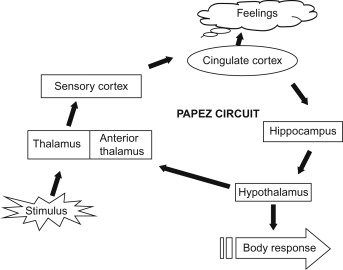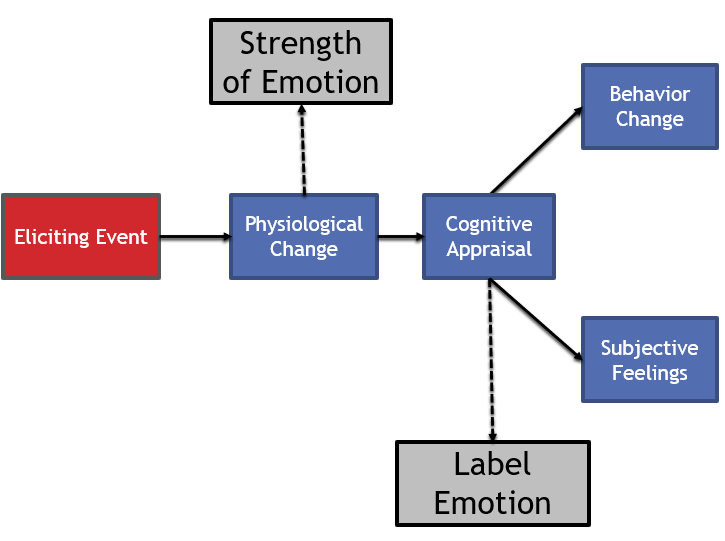Affect and Emotion 1
1/33
There's no tags or description
Looks like no tags are added yet.
Name | Mastery | Learn | Test | Matching | Spaced |
|---|
No study sessions yet.
34 Terms
A useful analogy
sensations => affect => emotions
dimensions of affect
valence
arousal activation intensity
valence
positive vs. negative
approach vs. avoid
goal-conduciveness
arousal activation intensity
high, medium, low activation
phineas gage
accident destroyed parts of medial frontal cortex
survived but changed personality. couldn’t hold down job, became vulgar, impulsive, and temperamental
cats displayed normal emotional reactions to dogs after severing
sympathetic afferents from the body
cats displayed exacerbated responses to benign stimuli (sham rage) after
removing full neocortex, but not when thalamus/midbrain included
stimulation of hypothalamic regions can produce
similar defensive behaviors or the desire for further stimulation
papez circuit
control memory and emotions

kluver-bucy syndrome
monkeys with temporal lobectomy were:
less emotionally reactive
less reactive to novelty/exploration
hyperoral/hyperphagic
removal of amygdalae was sufficient to obtain symptoms of
kluver-bucy syndrome
reptilian brain (basal ganglia)
primitive surivival-related emotions (e.g., fear, aggresion); reflexive
visceral/paleomammalian brain
aka limbic system
integrates sensory, bodily signals
elaborated emotions, learning
neomammalian brain (neocortex)
abstract thought, prospecion, reasoning
emotion-cognition interface
regulation of emotions
the limbic system
includes papez circuit
hypo/thalamus, cingulate, hippocampus
adds regions such as amygdala, insula, ventral PFC
James-Lange theory
stimulus => autonomic response => behavioral response => emotion
Cannon-Bard theory
stimulus => central response => autonomic response AND emotion
Schacter’s theory
proposes that emotions are a result of two key components: physiological arousal and cognitive interpretation

temporal distinctions in reward processing
Reward unfolds over time in two key phases:
Anticipatory (appetitive): before the reward occurs — the desire, expectation, or craving.
Consummatory (experienced): after receiving the reward — the pleasure or satisfaction of consuming it.
functional distinctions in reward processing
Each phase can be linked to a specific function:
Wanting: the motivational drive to obtain a reward (e.g., craving, effort to get chocolate).
Liking: the actual pleasure from experiencing the reward (e.g., enjoying the chocolate).
Learning: using past rewards to predict future outcomes (e.g., remembering that chocolate is good).
These are not always aligned — for instance, people with addiction might "want" a drug intensely without "liking" it as much anymore.
neural evidence of wanting
linked to dopamine systems, especially in the ventral pallidum (VP)
Dopamine increases wanting but doesn’t necessarily increase liking.
neural evidence of liking
involves opioid systems and more localized "hedonic hotspots" in the brain.
opiod stimulant enhances liking
reward/pleasure circuits
wide and distributed set of regions associated with wanting
hedonic hotspots
narrower subset of reward/pleasure circuits linked to liking
defensive responses to potential threats (e.g., flight, freeze, flee) are determined by
the predator proximity, and possibility of escape
and shaped by ecological nice
the amygdala is critical for mediating
innate and learned associations between stimuli and appropriate behavioral programs (e.g., defensive freezing)
avoidant behavior in rats
Amg or PAG stim generates avoidance
SM & personal space
patient with amg lesion needed less personal space between her and experimenter
generalization of aversive associations
After learning that a certain stimulus (like a tone or image) predicts something negative (like a shock), people and animals often:
Respond fearfully not only to that exact stimulus (called the CS+, or conditioned stimulus),
But also to similar but new stimuli (generalization stimuli, GSs).
brain regions that selectively track positive outcomes
vMPFC Str
Positive > Negative Affect
brain regions that selectively track negative outcomes
dMPFC Amyg Ant. Insula
Negative > Positive Affect
Insula lesions impair
learning from losses, leave gain learning intact
amygdala lesions exhibit
no/reversed loss aversion during risky choice